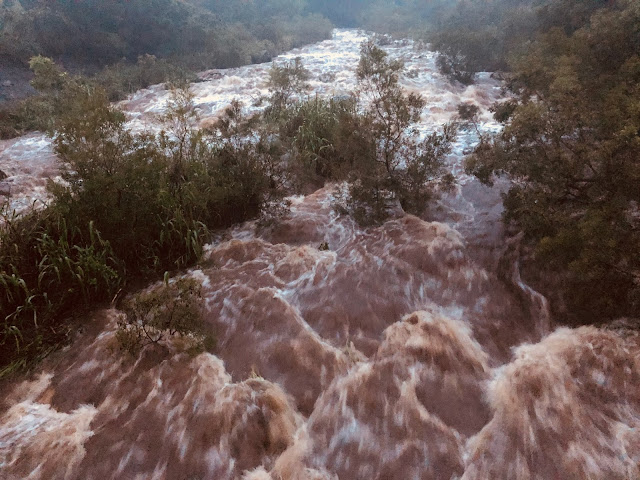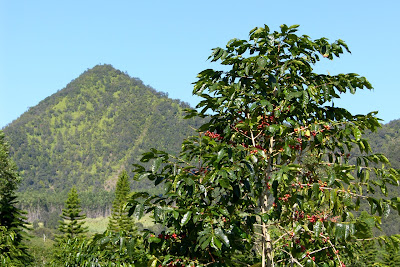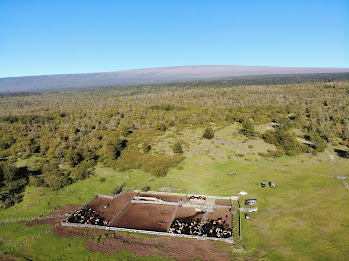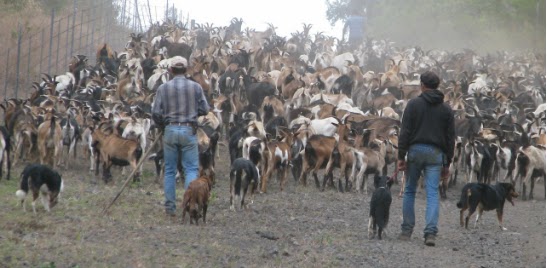On the road again in October, the Trojans travel to Hawai‘i Preparatory Academy on Saturday, Oct. 7 at 2 p.m. and return home to take on Kamehameha on Saturday, Oct. 14 at 1 p.m.
Ka‘ū High School's football team is comprised of students from its own campus and students from Volcano School of the Arts & Sciences.
 |
Ranchos resident John Fretz used an aerial photo of his Ocean View Ranchos neighborhood to superimpose the concept of industrial solar farms on two three-acre lots amid existing homes, the solar farms surrounded with fencing and lights. Image by John Fretz |
FATAL FIRES IN LĀHAINĀ ARE PROMPTING RANCHOS RESIDENTS TO ASK GOVERNMENT AUTHORITIES TO STOP CONSTRUCTION OF INDUSTRIAL SOLAR FARMS IN THEIR NEIGHBORHOOD. Rick Allen, a former first responder in Maui, who lives in the Ranchos community in Ocean View, said, "We had the situation in Maui with telephone poles that are overstrung coming down in high winds. Now we have the same in Ranchos, and 17 solar farms are going to be plugging into those lines.
"We have no idea who these people are, or their safety record. They will be using our roads and using our poles. For over 50 years, Ranchos had been a residential and ag community and now we are to be suddenly industrialized. I see this as a serious danger to our community."
Sandy Mayville, a Ranchos homeowner, said she is concerned about the volume and size of the vegetation covering open land within the subdivision. "We have a lot of huge Christmas Berry bushes, which are rich in oils and burn like crazy. Add that to introduced grasses, like Fountain Grass and we have a tinder box right in our back yards. Seventeen new power-generating plants represent a lot more risk of industrial-scale fires than if 17 regular homes were built on the lots.
"Like Lāhainā, we have a single highway running east-west. Unlike Lāhainā, we have only two ways of accessing the highway, and both of them pass through the thickest concentration of Christmas Berry trees. Our prevailing winds, the trades, will spread the fires in such a way that exits from the subdivision are likely to be cut off. And since we don't have ocean access, how will the residents from over 200 homes save themselves?"
.JPG) |
Rancho residents who have long opposed industrial solar in their neighborhood are pointing
to fire risks in the wake of the Lāhainā firestorm. |
Deborah Ward, a Sierra Club activist, pointed to "the catastrophic tragedy" that destroyed Lāhainā on Maui. "Let's be mindful of the potential for a similar outcome in our community. Ocean View has a volunteer fire department that is not trained or equipped to fight electrical fires. Ranchos has no piped county water and no fire hydrants. Water to fight the fires will have to be trucked in."
Phillis May, a former President the Hawai‘i Ranchos Road Maintenance Corp., told
The Ka‘ū Calendar that in Ranchos fire would be a major concern. "Electrical shorts and faults could be caused by any number of factors." She said, "Our strong winds in Ka‘ū could bring down high-voltage lines," referring to winds that power 12 windmills at South Point.
May said, "People attempting theft or damage to solar installations could cause a fire. Anything that creates sparks could start a fire, and when those sparks are carried by our high winds to dry vegetation, Ranchos residents would be in real danger.
"It will be impossible to police 26 separate solar installations scattered, patch-work quilt style, among existing homes. HELCO cannot guarantee our safety nor working phones and internet during a disaster. The history of major fires with great loss of life and property has shown this to be true on Maui and in California.
"Ocean View is not equipped to deal with industrial-scale fires. I think the whole project should be moved to a larger site and built as a contiguous solar farm. Then it can be fenced and secured at one location.
"That's how it's done everywhere else. Why not Ocean View?" asked May.
Bob Werner, a former elected Assessor-Recorder of Fresno County in California, and resident of Ranchos, told
.jpg) |
A Ranchos neighborhood without solar. See concept photo above with solar.
Photo by John Fretz |
The Ka‘ū Calendar that for his job he considered a wide range of possible effects of proposed projects. "We had to consider projects that would affect property values and county revenues, those that would affect our citizens' health and safety, and those things that would increase or decrease the prosperity of our businesses and residents.
"The 26 'solar farms' being proposed for development in Ocean View fail on each of these points, and more," said Werner, adding "it is actually incomprehensible to me that this project was ever seriously considered, let alone allowed to progress to its current state. This project would also bring with it serious risk of fire as the project would be generating and carrying high-voltage electricity.
"We have likely seen the result of high voltage arcing in the devastating fires in Lāhainā. Much of upper Ranchos has similar ground cover and foliage as that which caught fire in Lāhainā. This project would bring that same risk to our homes and the homes of our neighbors," said Werner.
Werner said, "As best I can tell, this would not even lead to lower electrical rates or greater energy independence and sustainability for the people of the Big Island. The only possible beneficiary of this project would be the foreign companies that stand to profit on the obscene rates of payment and the potential tax subsidies."
 |
Council member Michelle Galimba
said she has serious concerns about
the industrial solar farm project. |
County Council member Michelle Galimba said in March, "I have serious concerns over this project because of the potential for increased costs for all HELCO customers, as well as inappropriate industrial land use in a rural residential community. I urge the developers to reconsider a project that is so unpopular among the local residents."
The project comes out of a renewable energy program dating from 2008, with the 26 power-generating installations to be located on 26 sites, among existing homes, largely in Ranchos. Each site would be covered with about 1,200 solar panels that would generate a quarter megawatt of power.
The project would need a new substation and a new overhead transmission line that would be built on land owned by Ranchos property owners. The power would be fed into the grid and, since it is not needed in Ocean View, it would be used by the larger towns north.
Since 2015, Ocean View residents have voiced opposition to the project at community meetings, in letters to the Public Utilities Commission and in numerous press reports. Elected representatives have joined them with letters to the PUC. Over 700 residents signed a petition. On August 29, 2016, two Ranchos residents filed a Formal Complaint with the PUC, which, seven years later, is still ongoing.
Unless the PUC ends the program, the project will go forward, said Annie and Peter Bosted who have opposed the project before the PUC. They estimate that SPI, the owner of the project based in Shanghai, will profit more than $54 million over 20 years from "windfall rates" offered in the program. They said that many Ranchos residents are concerned about degradation of property values should the industrial "eyesore" be built. "Since witnessing the fatal fires in Maui, which were allegedly caused by sparks from downed lines, residents also fear for their lives and their homes," said a statement from the Bosteds.
DR. LIS GALLANT, WHO JUST FINISHED A POST DOC ON LAVA AND CINDER CONES AT KILAUEA, is the subject of this week's
Volcano Watch, the weekly column from USGS Hawaiian Volcano Observatory. Her National Science Foundation Postdoctoral Fellow research studied lava and cinder cones from the 2018 eruption of Kīlauea. She next moves from USGS to Department of Geology at the University of Hawai‘i at Hilo as an Assistant Professor.
Learn more about the Department of Geology at the University of Hawai‘i at Hilo.
Volcanology was not always on the horizon for Gallant when she started her academic journey in
 |
Dr. Lis Gallant moves from Hawaiian Volcano Observatory
to University of Hawai‘i at Hilo. Image from LinkedIn |
Troy, New York. She took courses at Hudson Valley Community College before receiving a Bachelor’s degree in Electronic Media, Arts, and Communications from Rensselaer Polytechnic Institute. After several years working in the medical software industry, she returned to school and received a second Bachelor’s in Geology from Buffalo State University.
As an undergraduate student, Gallant conducted research on
tephra deposits of Santa Ana Volcano in El Salvador, which helped her discover a passion for science with real-world application. It was after this that she first came to the Island of Hawai‘i to work at HVO as an intern mapping
lava flows on Mauna Loa and assisting in Puʻuʻōʻō eruption response from 2012 to 2013.
Gallant then went to the University of South Florida to pursue both a Master’s and Ph.D. in geoscience. Her work focused on developing new computer-based
lava flow hazard assessment tools. Lis also expanded her skill set by working with different kinds of radar to study subtle changes in the shapes of volcanoes and map eruptive deposits below the ground.
In addition to her research, she was an avid teacher while working on her degree, instructing numerous courses and assisting with USF’s summer field courses. She taught students from Florida—many of whom had never seen mountains before—to map folds, faults, and geologic deposits for the first time!
While at USF, Gallant was part of the response to volcanic unrest at Nevado del Ruiz, in Colombia, and the eruption of Momotombo in Nicaragua.
 |
Dr. Lis Gallant deploying a terrestrial radar system during the January 2023 eruption of Kīlauea. This instrument can detect small-scale changes in the shape of the lake’s surface and calculate the speed at which those changes are occurring. USGS photo
|
These experiences further bridged the gap between academic research and applied science, which set Gallant on her path after she graduated with her Ph.D.
Gallant moved to the United Kingdom in 2020 and joined the IMAGINE project at the University of Cambridge Department of Geography. Although the COVID-19 pandemic prevented her from traveling to Chile and Argentina to examine the human and environmental geographies in these volcanic regions, she was able to forge strong connections with her colleagues and she looks forward to engaging UHH students in this network.
Gallant returned to HVO in 2021 and continues to engage in both exciting research and eruption response efforts. She has helped respond to the 2020, 2021, and 2023 eruptions of Kīlauea and the 2022 Mauna Loa eruption.
Gallant brought several pieces of novel scientific equipment to study the volcanoes, including a magnetometer mounted on an uncrewed aerial vehicle, a
ground penetrating radar, and a special radar that can detect rapid changes in the shape of the landscape (a terrestrial radar interferometer).
The TRI was deployed during the waning phases of the Mauna Loa eruption. The flow front was difficult to continuously monitor due to inclement weather and the logistical constraints of working at high altitudes. Gallant and graduate students from USF successfully located the flow front in near-zero visibility conditions and were able to image flow thickening along the margins.
Gallant continued to teach during her time at HVO. She is a faculty member for the
GeoSPACE project, a field course that focuses on improving the experiences of disabled students in the geosciences. Her efforts were recently recognized by the International Association for Geoscience Diversity when they presented her with their Inclusive Geoscience Education and Research Award in 2022.
Gallant said she is excited to bring all of these amazing assets—passion for teaching, diversifying the geosciences, and volcano research—to her students as she begins her first semester at UHH. Although we will certainly miss her at HVO, we look forward to collaborating with her as a UHH partner. UHH has been an active partner with HVO for many years and this relationship will continue to thrive with the Department of Geology’s newest professor.
 |
Dr. Lis Gallant measuring fountain heights during the 2022 eruption of Mauna Loa using a laser rangefinder. USGS photo |
. See latest print edition at
kaucalendar.com, in the mail and on stands.
Volcano Activity Updates: Kīlauea is not erupting. Its USGS Volcano Alert level is ADVISORY. Active lava has not been visible within Halemaʻumaʻu crater at the summit of Kīlauea since June 19. Over the past week, earthquake activity in the summit region remained elevated and summit tiltmeters generally showed inflation. A sulfur dioxide (SO2) emission rate of approximately 86 tonnes per day was measured on August 15.
Mauna Loa is not erupting. Its USGS Volcano Alert Level is at NORMAL. Webcams show no signs of activity on Mauna Loa. Seismicity remains low. Summit ground deformation rates indicate slow inflation as magma replenishes the reservoir system following the recent eruption. SO2 emission rates are at background levels.
There were three earthquakes with three or more felt reports in the Hawaiian Islands during the week ending last Thursday: a M3.2 earthquake 21 km (13 mi) SW of Laupāhoehoe at 29 km (18 mi) depth on Aug. 22 at 6:54 p.m. HST, a M3.4 earthquake 11 km (6 mi) E of Pāhala at 32 km (20 mi) depth on Aug. 20 at 12:05 p.m. HST, and a M2.4 earthquake 3 km (1 mi) SSW of Volcano at 2 km (1 mi) depth on Aug. 17 at 2:03 p.m. HST.
TARA LITTLE, LAST SEEN IN OCEAN VIEW, IS MISSING. Hawaiʻi Island police are asking for the public’s assistance in locating 48-year-old Tara Little, of Ka’u, who was reported missing.
 |
Tara Little, last seen in Ocean View. Photo from HPD |
She is considered endangered as she is in need of medication for a medical condition. Little was last seen on Friday, Aug 25, during the afternoon hours in the Hawaii Ocean View Estates subdivision. Little is described as being 5’06” tall, weighing approximately 260 pounds, and having a light skin complexion with brown hair and brown eyes. She was last seen wearing a pink colored dress and white shoes.
Police ask anyone who may have information on Little’s whereabouts to call the Hawaii Police Department’s non-emergency number at (808) 935-3311; or Detective Donovan Kohara at (808) 960-3118; or via email at
donovan.kohara@hawaiicounty.gov.Tipsters who prefer to remain anonymous may call the island-wide
Crime Stoppers number at 961-8300 and may be eligible for a reward of up to $1,000.00. Crime Stoppers is a volunteer program run by ordinary citizens who want to keep their community safe. Crime Stoppers does not record calls or subscribe to any Caller ID service. All Crime Stoppers information is kept confidential.





.png)
-1.jpg)

.jpg)
%20(2).jpg)
%20(1).jpg)
.jpg)



.jpg)







.jpg)
.jpg)
.jpg)






.jpg)
.jpg)
.jpg)


.JPG)

.jpg)






